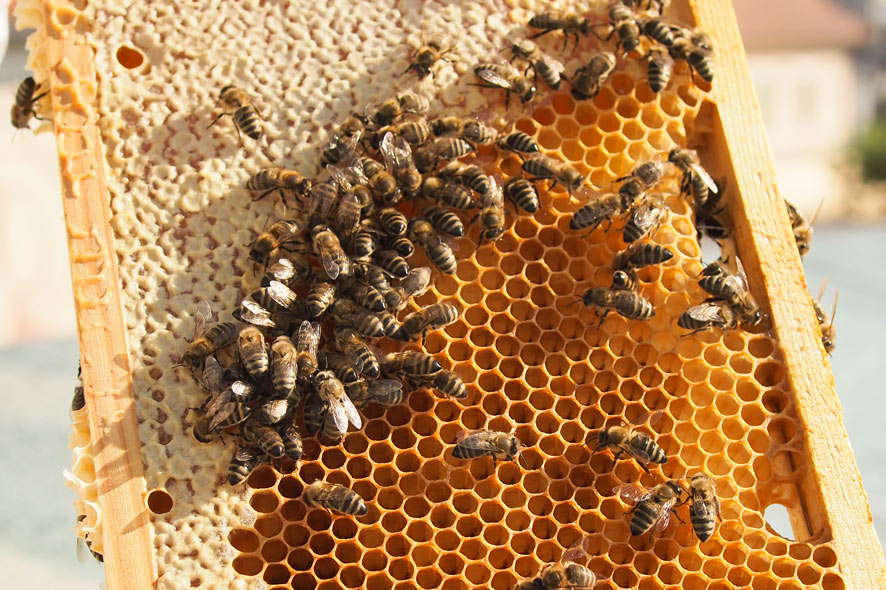Who would have thought that a bee’s most dangerous task is fetching water? Bees are designed for maximum efficiency and aren’t the least bit egocentric, so is it even possible to compare them to human beings? Their home base atop the Ars Electronica Center in Linz provides bees with a superb habitat close to the banks of the Danube and the parks nearby. The delicious honey they produce here in the inner city serves, above all, to nurture the next generation of bees.
How did bees actually come to live on the roof of the Ars Electronica Center?
Harald Wohlschlager: In 2014, we launched DACHMARKE* [umbrella brand; literally “roof brand”], an initiative to set up beehives atop Linz cultural institutions like the Ars Electronica Center. This initiative is meant to bring people closer to bees, and the AEC’s rooftop offers a great setting for this to happen.
Is this your only beehive?
Harald Wohlschlager: I’m a beekeeper and the Ars Electronica Center is one of my sites. It’s my favorite location because here you always meet interesting people you can get into a stimulating conversation with. My other bees are in a nature preserve in the Mühlviertel region north of Linz, in a forest where there’s not a soul living far and wide. Now, you might assume that bees are better off there than they are in the heart of a big city but that’s a misconception. Here at the Ars Electronica Center, the bees are, in fact, considerably further developed. And they also produce single-origin [unmixed] honey that is then filled into jars and put on sale at the Ars Electronica Center.
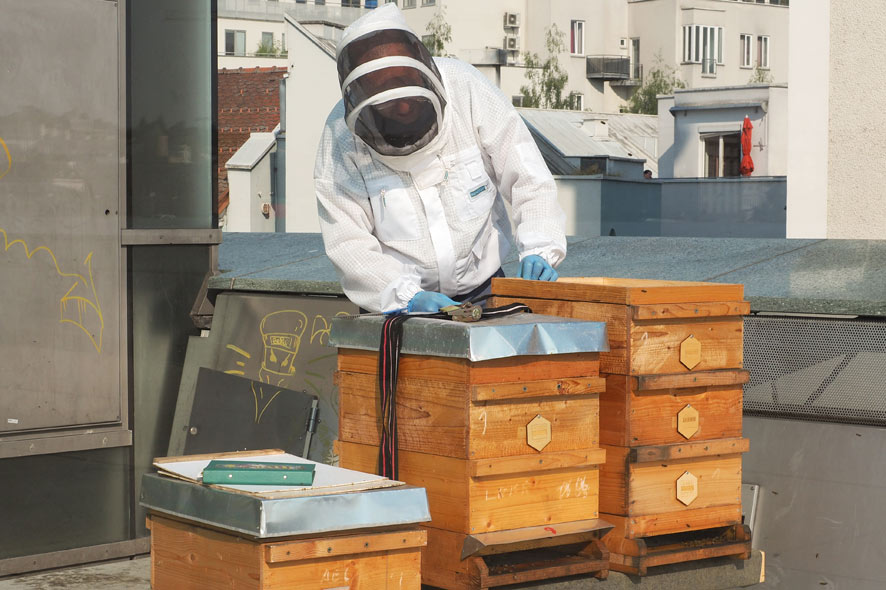
Beekeeper Harald Wohlschlager opens one of the beehives. Credit: Martin Hieslmair
How often do you have to tend to your beehives each year?
Harald Wohlschlager: It depends on the season and the weather. Now, in May, I have to come once a week to make sure that the bees can develop and have enough space. That continues on into June. After the summer solstice, I reduce the frequency of my inspections to once every two months, just to make sure that they’re doing fine.
What’s special about this beehive here at the Ars Electronica Center?
Harald Wohlschlager: There are two outstanding characteristics of this location. There’s the contact with the general public, whereby people from all over the world can get acquainted with beekeeping and bees. And the physical location itself is extraordinary because there are so many different trees all around. When you consider that a chestnut tree in full bloom is the equivalent of a 1.5 hectare [3.7 acre] flowering meadow and there are 30 such trees very close by, then you can calculate the size of the meadow that that amounts to. And when you take into account all the monocultures that have been cropping up just about everywhere you look, you realize that a landscape as diversified as this has unfortunately become something of a rarity. That’s why the Ars Electronica Center is such an excellent location, and also thanks to the lighting conditions here. It’s simply ideal!

The beehives atop of the Ars Electronica Futurelab. Credit: Martin Hieslmair
A trick had to be used in order for the bees to get settled in here …
Harald Wohlschlager: Yes indeed. If you take a beehive and move it two meters from its original location, the bees will still fly back to where it was before. But when I wanted to resettle the bees to the Ars Electronica Center from a location that’s less than five kilometers away from here, then I first had to bring the bees to a spot more than five kilometers away and let them stay there for about two weeks until they forgot where their home was. Only then could I bring them here, whereupon they had no problem flying into the hive’s entrance hole and making themselves at home.
How many bees actually live on the roof of the Ars Electronica Center?
Harald Wohlschlager: At present there are three to five hives atop the Ars Electronica Center, which is ideal for me because I can provide them with proper care. In the winter, you proceed on the basis of about 3,000 bees living in a hive here. In February, the queen of this population begins to lay about 2-3,000 eggs per day. A hive’s population reaches its peak of about 60,000 bees in May. Around the summer solstice, the population starts to slowly dwindle again, so that at the winter solstice it’s down to only 3,000 bees per hive. The bees that are now alive in May won’t live particularly long—depending on the weather conditions and whether they have to do a lot of flying or not, they live for about a month. The winter bees have to hold out for a whole year, keep each other warm and live off the stored-up food in order to carry out this enormous development process in spring.
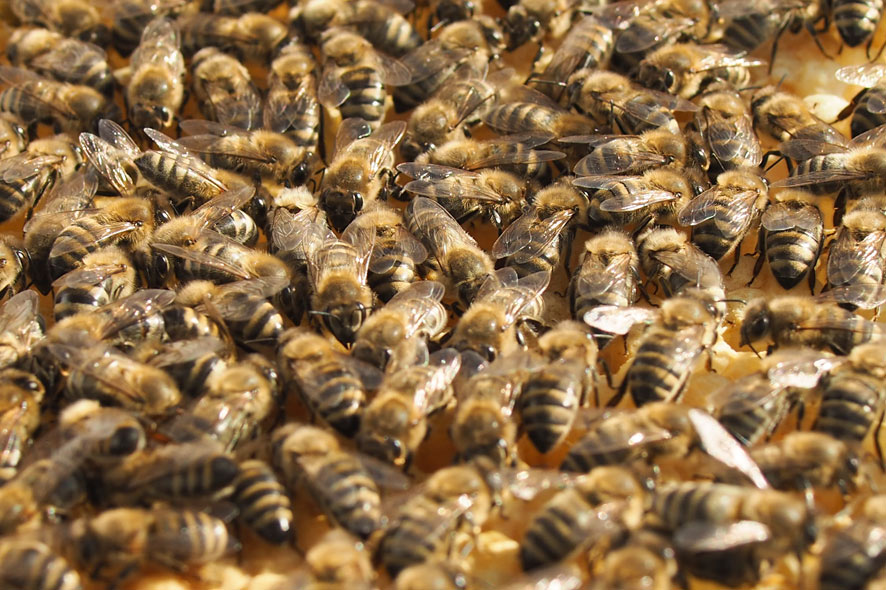
Credit: Martin Hieslmair
Bees have different roles depending on their age. Could you tell us more about that?
Harald Wohlschlager: The bee is designed for maximum efficiency. Everything a bee does is maximally efficient. When it gathers nectar, it takes the closest blossom with the greatest yield. And so is the assignment of roles among the hive population. A newborn bee is given the simplest and least dangerous job—cleaning the breeding place—and can start feeding the brood. Then it’s in line to do construction work within the hive and does jobs that successively take it closer and closer to the entrance hole. This is the most dangerous area because it entails encounters with predators, so here it does guard duty. Once it has mastered that, it can fly out to collect nectar and pollen. And when it has successfully fulfilled that task, it’s chosen to fetch water—a bee’s ultimate mission due to the high risk of drowning. If a young bee were given this task and died trying, then most of its output would be lost. Here, everything is maximally efficient and not egocentric.
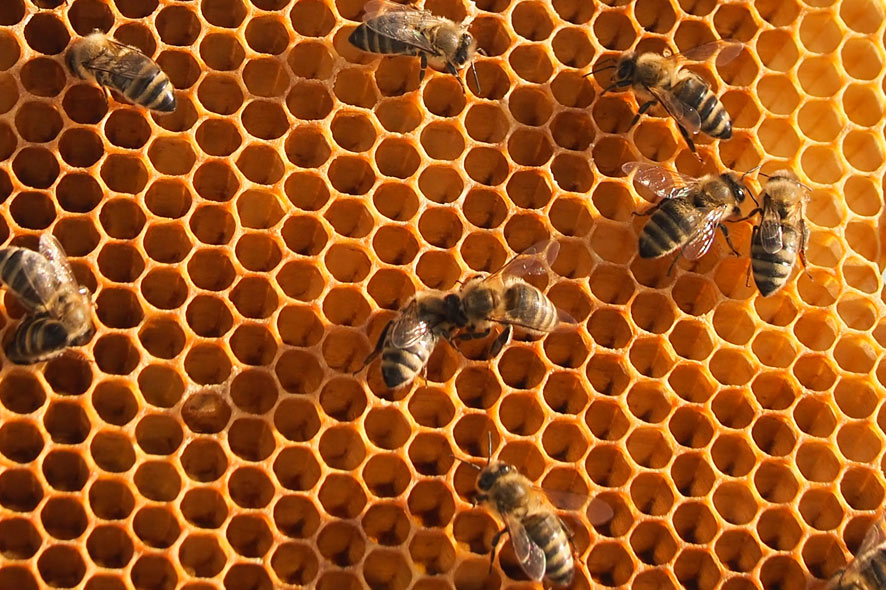
Credit: Martin Hieslmair
Is it actually even admissible to compare human beings to bees?
Harald Wohlschlager: A comparison with Homo sapiens is actually almost impossible. In this case, the bee is the equivalent of a human cell and the bee colony corresponds to the entire human body. The bee is one of the few animals that doesn’t work to sustain itself but rather just on behalf of the others. The bee gathers nectar and pollen only for the others so that the colony can share, proliferate and make it through the winter. What an individual bee collects isn’t for its own good, it never benefits personally. And if a bee is sick, it’s expelled from the hive to prevent it from infecting another insects, which thwarts the propagation of diseases. Thus, honey and the bees’ other products are especially healthy because they’re designed to be kept absolutely sterile and free of bacteria, and bees only use natural substances that support them in keeping it that way.
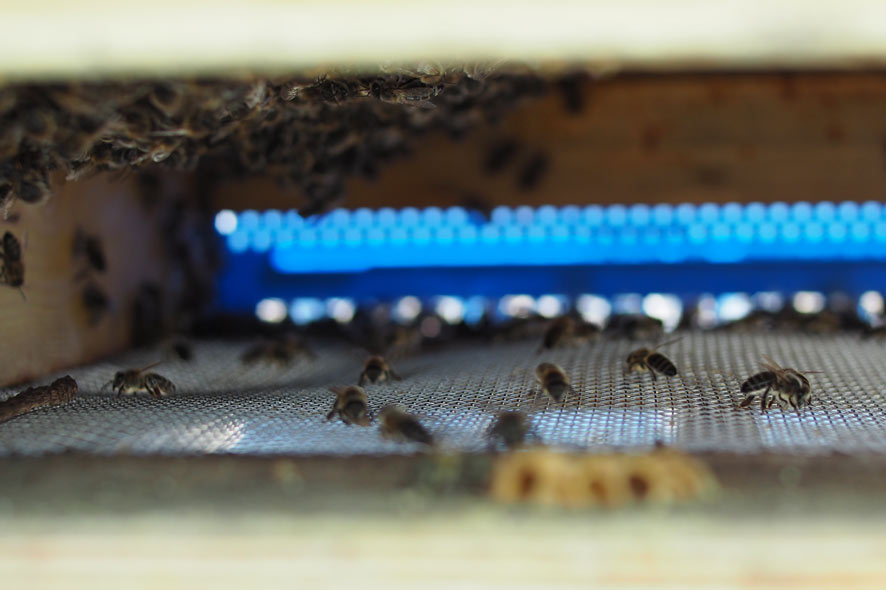
Credit: Martin Hieslmair
Now, there’s live webcam footage available at ars.electronica.art/bees that gives visitors a close-up look at the bees and their activities. What do you get to see?
Harald Wohlschlager: A webcam has been installed in one of the beehives, in the lower area where it’s pointed at the entrance hole, so you see how the individual bees fly in from outside and deliver their pollen or nectar to the other bees. And you can observe the transition that goes on over the course of a day from early morning to evening. Initially, the hive is jam-packed; then, many bees fly out and the number inside diminishes. And you can also see the various behavioral patterns of the individual bees—some are just hanging around doing nothing, while others are very hardworking. But logic governs everything that happens in a beehive.
The glass enclosure on the roof of the Ars Electronica Center now makes it possible to observe the hives right up close. When I happen to be on site, I show interested youngsters and grown-ups what the queen looks like, and I even demonstrate that you can pet certain bees. Individuals or school groups who would like to arrange a guided tour can contact me on honig@süsses-gold.at and we’ll set up an appointment.

Harald Wohlschlager lives in Linz and works for an IT firm in Steyr. Beekeeping has been his hobby since 2012. He tends 30 hives—on the roof of the Ars Electronica Center, in the Tal der kleinen Gusen nature preserve, and in Sterngartl in Upper Austria’s Mühlviertel region. His organic honey is marketed as Süßes Gold [sweet gold], and is on sale at, among other places, the Ars Electronica Center Shop.
